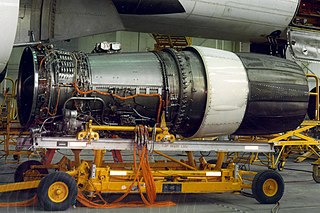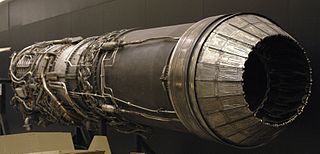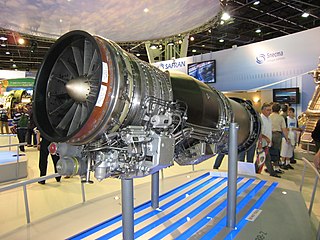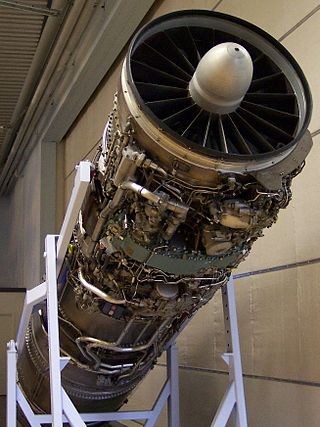
The Engine Alliance GP7000 is a turbofan jet engine manufactured by Engine Alliance, a joint venture between General Electric and Pratt & Whitney. It is one of the powerplant options available for the Airbus A380, along with the Rolls-Royce Trent 900.

The General Electric F110 is an afterburning turbofan jet engine produced by GE Aerospace. The engine is derived from the General Electric F101 and primarily powers tactical fighter aircraft. The F118 is a non-afterburning variant of the F110. The engine is also built by IHI Corporation in Japan, TUSAŞ Engine Industries (TEI) in Turkey, and in several other countries as part of licensing agreements.

The General Electric F101 is an afterburning turbofan jet engine. It powers the Rockwell B-1 Lancer strategic bomber fleet of the USAF. In full afterburner it produces a thrust of more than 30,000 pounds-force (130 kN). The F101 was GE's first turbofan with an afterburner.

Volvo Aero was a Swedish aircraft, guided missiles and rocket engine manufacturer. It became GKN Aerospace Engine Systems following the company's acquisition by British engineering conglomerate GKN during 2012.

The Pratt & Whitney F100 is an afterburning turbofan engine manufactured by Pratt & Whitney that powers the F-15 Eagle and F-16 Fighting Falcon.

The General Electric J79 is an axial-flow turbojet engine built for use in a variety of fighter and bomber aircraft and a supersonic cruise missile. The J79 was produced by General Electric Aircraft Engines in the United States, and under license by several other companies worldwide. Among its major uses was the F-104 Starfighter, B-58 Hustler, F-4 Phantom II, A-5 Vigilante and IAI Kfir.

The General Electric/Allison J35 was the United States Air Force's first axial-flow compressor jet engine. Originally developed by General Electric in parallel with the Whittle-based centrifugal-flow J33, the J35 was a fairly simple turbojet, consisting of an eleven-stage axial-flow compressor and a single-stage turbine. With the afterburner, which most models carried, it produced a thrust of 7,400 lbf (33 kN).

The Rolls-Royce Avon was the first axial flow jet engine designed and produced by Rolls-Royce. Introduced in 1950, the engine went on to become one of their most successful post-World War II engine designs. It was used in a wide variety of aircraft, both military and civilian, as well as versions for stationary and maritime power.

The de Havilland Ghost was the de Havilland Engine Company's second design of a turbojet engine to enter production and the world's first gas turbine engine to enter airline service. The Ghost powered the de Havilland Venom, de Havilland Comet and SAAB 29 Tunnan. It was a scaled-up development of the Goblin.

The General Electric J85 is a small single-shaft turbojet engine. Military versions produce up to 2,950 lbf (13.1 kN) of thrust dry; afterburning variants can reach up to 5,000 lbf (22 kN). The engine, depending upon additional equipment and specific model, weighs from 300 to 500 pounds. It is one of GE's most successful and longest in service military jet engines, with the civilian versions having logged over 16.5 million hours of operation. The United States Air Force plans to continue using the J85 in aircraft through 2040. Civilian models, known as the CJ610, are similar but supplied without an afterburner and are identical to non-afterburning J85 variants, while the CF700 adds a rear-mounted fan for improved fuel economy.

The General Electric F404 and F412 are a family of afterburning turbofan engines in the 10,500–19,000 lbf (47–85 kN) class. The series is produced by GE Aerospace. Partners include Volvo Aero, which builds the RM12 variant. The F404 was developed into the larger F414 turbofan, as well as the experimental GE36 civil propfan.

The Snecma M88 is a French afterburning turbofan engine developed by Snecma for the Dassault Rafale fighter.

The General Electric F414 is an American afterburning turbofan engine in the 22,000-pound thrust class produced by GE Aerospace. The F414 originated from GE's widely used F404 turbofan, enlarged and improved for use in the Boeing F/A-18E/F Super Hornet. The engine was developed from the F412 non-afterburning turbofan planned for the A-12 Avenger II, before it was canceled.

The GTRE GTX-35VS Kaveri is an afterburning turbofan project developed by the Gas Turbine Research Establishment (GTRE), a lab under the Defence Research and Development Organisation (DRDO) in Bengaluru, India. An Indian design, the Kaveri was originally intended to power production models of the HAL Tejas Light Combat Aircraft (LCA) developed by Hindustan Aeronautics Limited. However, the Kaveri programme failed to satisfy the necessary technical requirements or keep up with its envisaged timelines and was officially delinked from the Tejas programme in September 2008.

The CFE CFE738 is a small turbofan engine aimed at the business/commuter jet market manufactured by the CFE Company, and is used on the Dassault Falcon 2000.

The Honeywell/ITEC F124 is a low-bypass turbofan engine derived from the civilian Honeywell TFE731. The F125 is an afterburning version of the engine. The engine began development in the late 1970s for the Republic of China (Taiwan) Air Force AIDC F-CK Indigenous Defence Fighter (IDF), and it first ran in 1979. The F124/F125 engine has since been proposed for use on other aircraft, such as the T-45 Goshawk and the SEPECAT Jaguar, and currently powers the Aero L-159 Alca and the Alenia Aermacchi M-346. The F124 has a rather unusual design for a two spool gas turbine engine, using both axial and centrifugal compressors in its high-pressure compressor. There are currently only three production variants of the engine, although several more have been proposed throughout its lifespan.

The General Electric YJ93 turbojet engine was designed as the powerplant for both the North American XB-70 Valkyrie bomber and the North American XF-108 Rapier interceptor. The YJ93 was a single-shaft axial-flow turbojet with a variable-stator compressor and a fully variable convergent/divergent exhaust nozzle. The maximum sea-level thrust was 28,800 lbf (128 kN).

The General Electric GE4 turbojet engine was designed in the late 1960s as the powerplant for the Boeing 2707 supersonic transport. The GE4 was a nine-stage, single-shaft, axial-flow turbojet based largely on the General Electric YJ93 which powered the North American XB-70 bomber. The GE4 was the most powerful engine of its era, producing 50,000 lbf (220 kN) dry, and 65,000 lbf (290 kN) with afterburner. The Boeing 2707 was cancelled in 1971, putting an end to further work on the GE4.

The General Electric J73 turbojet was developed by General Electric from the earlier J47 engine. Its original USAF designation was J47-21, but with innovative features including variable inlet guide vanes, double-shell combustor case, and 50% greater airflow was redesignated J73. Its only operational use was in the North American F-86H.

The Volvo RM8 is a low-bypass afterburning turbofan jet engine developed for the Saab 37 Viggen fighter. An augmented bypass engine was required to give both better fuel consumption at cruise speeds and higher thrust boosting for its short take-off requirement than would be possible using a turbojet. In 1962, the civil Pratt & Whitney JT8D engine, as used for airliners such as the Boeing 727, was chosen as the only engine available which could be modified to meet the Viggen requirements. The RM8 was a licensed-built version of the JT8D, but extensively modified for supersonic speeds, with a Swedish-designed afterburner, and was produced by Svenska Flygmotor.





















